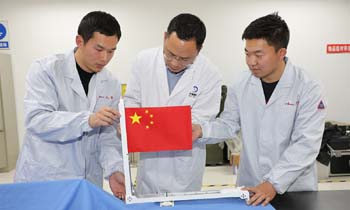
Chang’e-5 probe unfolds Chinese national flag
Deng Xiaoci and Fan Anqi
Beijing: The Chinese national flag shines an even brighter red from moon, and from now on it will be a grand reminder for stargazers from all over the world of the excitement and inspiration we felt from Apollo missions more than half a century ago.

Having packed samples of soil and rocks from the Earth’s only natural satellite within 19 hours after its smooth soft landing, the ascender of the Chinese spacecraft using the lander as a launch pad, took off from the moon surface, according to the China National Space Administration.
The Chinese space agency said in a statement the CNSA sent to the Global Times, the Chang’e-5 ascender has successfully taken off from the lunar surface with soil and rock samples, and sent to the lunar orbiter some 15 kilometers away with the 3,000-newton thrust engine.
Right before the lift-off of Chang’e-5’s ascender from lunar surface, the lander vehicle of the Chinese spacecraft unfolded the five-star red national flag, a genuine one made from fabrics, marking a first in the country’s aerospace history.
The probe’s successful launch from the lunar surface, as some observers believe, marks the completion of probably the most challenging step in the mission.
“This is the first attempt in China’s aerospace history to lift off from a celestial body other than Earth,” chief editor of Aerospace Knowledge magazine Wang Ya’nan said. “The launch is a major test, in that the vehicle had to rely entirely on automatic maneuvers without any ground command.”
Wang explained to the Global Times that the launch from the moon could not afford any time delay. “If the probe receives a command from the Earth to help it control the separation, altitude and speed, there will be at least one second delay, which will put the process in great danger.”
Another factor that posed a challenge to the lunar takeoff is that the lander-ascender combination might sit on a slope, which would bring uncertainty to the probe’s altitude and position. It means that the probe must ensure its own altitude is precise enough to enter the designated orbit through automatic decision-making, according to a statement sent to the Global Times from the China Aerospace Science and Technology Corporation (CASC).
Chinese researchers have conducted numerous ground simulations to verify the takeoff, but the particularities of the lunar environment have made the verifications difficult, the CASC said.
The rendezvous and docking, if successful, could be of great value to other deep-space or even manned missions in the future, the significance of which would be no less than the Apollo mission, once the name card of human lunar exploration activities during the Cold War, Chinese analysts said.
“It will be a milestone for China’s aerospace development,” Song Zhongping, an aerospace expert and TV commentator, said, calling it “a foresighted practice that lays a technological foundation for future deep-space explorations.”
It will also verify the viability of manned lunar landing missions, and even the construction of a lunar research base, or Mars missions, he told the Global Times.
